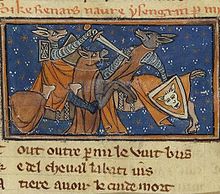Ysengrimus
As Ysengrimus (Isengrimus, -grinus) one is medium-Latin animal epic called, which was created in the mid-12th century (probably 1148/49), probably written by a cleric in Ghent .
Authorship
In later manuscripts the epic is ascribed to a Nivardus , a Balduinus Cecus and a Bernardus. The author's name Nivardus was known to researchers for the longest time, as the other two names were discovered late. That is why Nivardus is still often mentioned as the author's name, despite the uncertain attribution.
The text itself contains many references that suggest that Ysengrimus was composed by a cleric in Flanders (probably Ghent ) in the middle of the 12th century . Among others, Bernhard von Clairvaux , Anselm ( Bishop of Tournai ) and the Blandinium monastery near Ghent are mentioned and the failure of the second crusade is lamented.
Content and tradition

The epic is written in elegiac distiches and consists of almost 6600 verses. The main character is the wolf Ysengrimus, whose name was therefore used as the title. His opponent is the fox Reinardus, who brings about the gradual demise of the wolf. The Ysengrimus is therefore the first work in which the wolf and fox bear their later popular fable names Isegrim and Reinhart or Reineke .
Characterized as stupid and greedy, the wolf is outwitted by the cunning, devious fox in about a dozen episodes and is ultimately killed. The material draws on older narrative material ( Aesopian and medieval animal fables, the Ecbasis captivi , the collection of sayings and stories Fecunda ratis Egberts von Lüttich , the text De lupo from around 1100 ). Only the conclusion (death of the wolf by a herd of pigs) is an addition by the author, probably based on the Vita Mahumeti of the Embrichos of Mainz .
The main achievement of the poet consists in the composition of a self-contained epic, which artfully combined the various individual elements from the fable and animal poetry that was available in writing or orally at the time. In contrast to the ancient or medieval heroic epic, the protagonist in Ysengrimus is a negative figure, rightly destined to fall. By repeatedly presenting the greedy and stupid wolf as a monk and holder of spiritual dignity, the author caricatures the monasticism of his time, which in his opinion was in many respects worthy of criticism. In addition to many other motifs, for example the pairs of opposites “gate and wise man”, “poor and rich” or the Fortuna motif, the anti-clerical satire is the predominant theme of poetry.
The work is pervaded by irony and characterized by a punchy linguistic style, lively expression with a combination of folk drama and classical education. The text later served as a supplier of proverbs ( Florilegien ) and animal pans that were used in other animal poems (for example in the Roman de Renart and through further mediation, including the Central Dutch animal poem Van den vos Reynaerde , in the Reineke Fuchs ). A repositioning of the fourth and fifth episodes, called Ysengrimus abbreviatus , is regarded as a somewhat clumsy work in research and dates back to the end of the 13th century at the earliest. This abridged version also contributed to the spread of the work.
The animal pos has come down to us in 17 manuscripts, but only four of them provide the full text.
Editions and translations
- Franz Josef Mone : Reinardus Vulpes. Carmen epicum seculis IX. et XII. conscriptum. Reinhart Fuchs from the ninth and twelfth centuries. Stuttgart 1832.
- Ernst Voigt : Ysengrimus. Verlag der Buchhandlung des Waisenhauses, Halle an der Saale 1884, digitized version (basic text-critical edition). Reprint: Olms, Hildesheim 1974, ISBN 3-487-05284-9 .
- Jozef VanMierlo: Magister Nivardus' Isengrimus. Ysengrimus het vroegste dierenepos in de letterkunde der Nederlanden. Standaard Boekhandel, Antwerp 1946 (Dutch translation).
- Albert Schönfelder: Isengrimus. The Flemish animal pos. Low German studies 3. Böhlau, Münster 1955 (German translation).
- Francis J. Sypher, Eleanor Kramer Sypher: Ysengrimus by Magister Nivardus. Stinehour Press, New York 1980 (English translation).
- Elisabeth Charbonnier: Recherches sur l'Ysengrimus. Traduction et étude littéraire. Halosar, Vienna 1983, ISBN 3-900-26922-X (French translation).
- Jill Mann: Ysengrimus. Text with Translation, Commentary and Introduction. Middle Latin Texts XII. Brill, Leiden 1987, ISBN 90-04-08103-8 , digitized version (text with English translation).
- Mark Nieuwenhuis: Ysengrimus. Uit het Latijn vertaald. Amsterdam 1997 (Dutch translation).
- Michael Schilling: Ysengrimus. Tusculum Collection. De Gruyter, Berlin 2020, ISBN 978-3-11-066346-4 (bilingual edition Latin-German).
Ysengrimus abbreviatus :
- Jacob Grimm : Reinhart Fuchs. Reimer, Berlin 1834, pp. 1-24, digitized .
- Lieven van Acker: L'Ysengrimus Abbreviatus. In: Latomus 25 (1966), pp. 912-947.
literature
- Fritz Peter Knapp : The Latin animal pos . Scientific Book Society, Darmstadt 1979, ISBN 3-534-07808-X .
- Ludwig Gompf: Ysengrimus and the Gereon column . In: Udo Kindermann (Ed.): Festschrift for Pauk Klopsch. Kümmerle, Göppingen 1988, ISBN 3-87452-728-X .
- Francisco Rodríguez Adrados : Historia de la fábula fábula greco-latina II: La fabula en epoca imperial romana y medieval . Madrid 1985, ISBN 84-7491-160-5 , pp. 526-541.
- Teja Erb: Pauper et dives in Ysengrimus . In: Philologus 115, 1971, pp. 93-100.
- Hans Robert Jauß : Investigations on medieval animal poetry . In: Supplements to the Journal for Romance Philology 100, 1959.
Individual evidence
- ↑ Hs. Des Florilegium Gallicum (Berlin State Library, cod. Diez . B. Santen, 60, 5th - 13th / 14th century), extracts from Ysengrimus are titled "magister Niuardus de Ysengrino et reinardo"; see the entry in Ursula Winter's manuscript catalog
- ↑ Paris, Bibl. Nat., Cod. lat. 16708, on page 26v it says "Flosculi Balduini Ceci"
- ↑ Berlin State Library, cod. Phillipps 1827 (= Latin 193), 25v: "Proverbia Bernardi", cf. the entry in Valentin Rose's manuscript catalog .